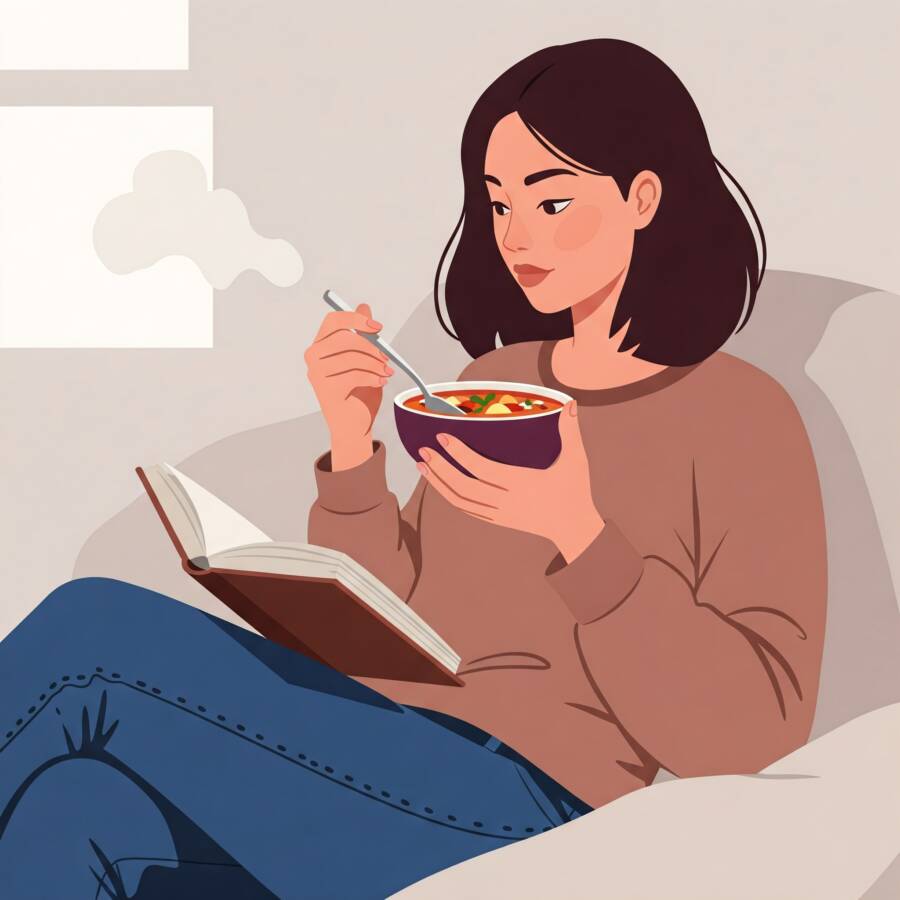Embrace Food Cravings as a Path to Self-Discovery and Freedom
It’s human to have food cravings, for sweet, salty, or that warm dish that feels like the warmth of your childhood.
Cravings seem to appear for all kinds of reasons. Sometimes it’s because your body needs specific nutrients, but most of the time they are tied to emotions and memories. You don’t have to see them as something to feel guilty about or fight against. You can actually use cravings as clues to understand yourself better.
Here you can learn how to embrace hidden messages in your cravings and build a healthy relationship with food.

Food cravings aren’t the bad guy.
If you’ve been told that it’s bad to have food cravings and they should be suppressed or controlled, that’s diet culture talking. Food cravings can be nutritional, emotional, and even stress-related. Instead of seeing them as problems to fix, you can look at them as a way to uncover some of your unmet needs and deep feelings.
When you enter intuitive eating, you’re encouraged to listen to your body’s desires and treat them as something to enjoy and explore, and there is research backing it up. Reviews suggest that intuitive eating supports positive mental health outcomes as well, and people noticed differences such as a more positive body image, higher self-esteem, and improved overall well-being.
A study taking place in 2020 about intuitive eating that tracked almost 1500 participants over eight years showed that:
People practicing intuitive eating were less likely to engage in disordered eating behaviors, and they also had lower body dissatisfaction; they were not relying on harmful weight-control practices, like using diet pills or skipping meals; they expressed fewer depressive symptoms and higher self-esteem.
There is a book embracing intuitive eating, called Women, Food and God, by Geneen Roth, who speaks about her own experience with disordered eating and how embracing food cravings was her way to find freedom.
Roth believes dieting isn’t really about food and health but about filling an inner void. When you shift perspectives, you can work with your cravings instead of seeing them as enemies. This is an open door for healing and self-discovery.
What’s beneath food cravings?
Cravings mask deep emotions, and if we try to control and suppress them, we won’t get to the root of the problem.
It was observed that food deprivation can increase cravings, and this way we can see they are not necessarily about nutrient or energy deficiencies, and sometimes they are learned, emotional responses to certain cues. The good part is that what is learned can be unlearned.
These are 7 ways to decode your food cravings and learn from them

1. Sit with the craving
Cravings are a natural part of life, so instead of pushing them away or giving in right away, why not sit with the feeling? Your cues give you insights into what your body is asking for.
This is an act of tuning that can help you connect with what you need, such as nourishment, emotional care, or rest. So you can try tuning into the craving and notice where you feel it in your body. Is it in your stomach? Throat? Feel the sensation fully and don’t try to explain or find a fast solution.
When you sit with it, you can notice memories, emotions, and images that are coming up. Simply allow this information to come naturally. You don’t need to have all the answers right away.
2. Explore ways to meet the need
You can try to meet the craving in other ways. Sometimes the cravings are not about food but about something deeper, so you can experiment with other ways to soothe yourself. You can, for example, drink a glass of water, take a warm bath, take a nap, call a friend, or go for a walk.
After you tried this and you noticed the urge isn’t as strong as it seemed, it could be a sign that the craving wasn’t about hunger.
3. Decide what feels right
After you’ve taken your time to explore cravings, you should check in with yourself. Do you still want to eat? Then go ahead and enjoy it without guilt! This is not about resisting cravings and relying on willpower—it’s about listening to them and learning from them. There is no “wrong” way.
Awareness of your belly
Intuitive eating practitioners are paying attention to their bellies. It’s a whole process to bring yourself back to your body and to your belly through your breath. This will make you feel more present. This can help you reconnect with the present moment and bring you clarity when it comes to choices and decisions taken from a place of awareness rather than impulse.
4. Delegate the decision-making
There is a common pitfall to get stuck in the question “Should I eat or not?”. This usually leads to overthinking and ultimately feeling overwhelmed. Specialists suggest that if you want to break free from the spiral, you need to delegate the decision-making process.
What does it mean?
Thankfully, the brain doesn’t have to be in control when it comes to burning calories. It’s our metabolism that handles it. Let’s see what happens when you trust your body.
This technique means trusting that your body knows what it’s doing, especially the parts that are responsible for cravings. If you think of your body as if it were a company, you can see the brain as the CEO. Your body is the trusted team that works smoothly to keep things running.
So, you can consider stepping back, trusting the process, and allowing your body to handle it. This will bring you peace of mind, and with that, some of the unhealthy cravings may stop appearing.
5. Learn your cues
Learning to listen to your own body’s cues is one of the most powerful practices. Sitting with your cravings involves moving away from external pressures back into your body. With more practice comes a better understanding of your body’s messages.
Diet culture can disconnect you from your natural instincts, getting you wrapped up in the aesthetic side of things. When you reconnect with your body signals, like cravings, hunger, or fullness, you’ll start to trust your inner guidance more than the outside opinions.
6. Celebrate cravings
Celebrate cravings as a line of communication with your body instead of seeing them as something to fear or control. Shifting your mindset will help you release the fear and begin to build a healthy, more intuitive relationship with food.

7. Ask yourself, “What else am I hungry for?”
Once you start to understand your cravings, you’ll get curious about what else they are trying to tell you.
By asking yourself, “What else am I hungry for?”
If you, for example, crave cake, you might know this isn’t the best choice for your health. However, instead of ignoring and denying the craving, you can try to see what’s behind the craving. It could come from deeper desires, such as love, comfort, community, pleasure, intimacy, or rest. Ask yourself and listen while opening up the possibility of uncovering what you like more and removing the forbidden fruit, making your cravings feel overwhelming.
Limiting yourself to something like you can only have dessert on the weekend can make the craving build up all week. When you have a little bit of what you’re craving throughout the week.
You can consider allowing yourself to have what you desire without restriction, as this can help cravings feel less intense. Food isn’t treated as something off-limits or special; it loses its hold on you so you can make mindful choices.
If you recently embraced intuitive eating, this is a workbook that you can find on Amazon, serving you both as a tracker and a guide. You can find it here: The Intuitive Eating Workbook: Ten Principles for Nourishing a Healthy Relationship with Food.
Did you like our article? Let us know in the comments what you think about intuitive eating. You can read this one next: Too Many Carbs? 6 Ways Your Body Tells You to Stop







